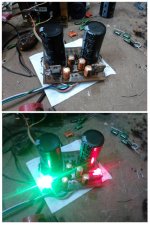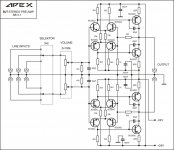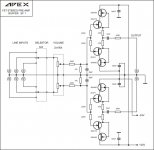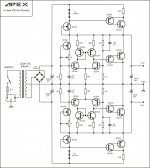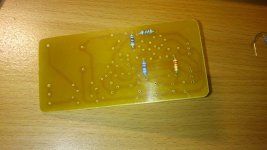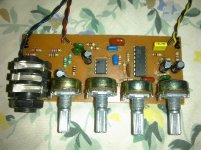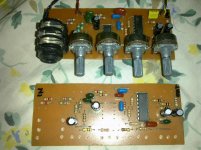Why does any builder choose a project for which he/she cannot buy the correct components?
The answer to your "Why" ................................................
There are several reasons.
1. Online shopping, bank-cards facility, paypal, etc. are not available everywhere in this global-village. As far as my memory scans the past- from a post of Mr Mile- Paypal is not available in Serbia. So many has no other alternatives but to look and drool over the components in the online shops with a " hope" that "someday.....perhaps someday, I might get that". I humbly belong to that section.
2. Recent trend of "use and throw" technology - Many cheap Chinese alternatives are available almost everywhere. A completely pre-assembled Chinese SMPS power supply with +-15V, +-12, 0-5v, +-9v output is available under 2 USD even here where I live.
So the average shop owners don't feel the urge to entertain a DIY-er as a natural consequence. It's hard to find 1% metal resistors too.
People simply throw a complete malfunctioning section away and attach a new module. That saves them from the hassles of fault finding and they can earn faster.
3. This sharp question has triggered a crucial personal issue. Earlier I had a major operation. After that I am almost home bound and physically not so fit. I cannot go and search all the shops in the major city alone. I am dependant on other to assist me. I am often under the clutch of excruciating pain. I found I used to be so happy with a long forgotten hobby ( the reason of my being here). So I took resort to this "old love" to get a relief and to forget pain and to be happy. And with the kind help of all friends here at DIYAUDIO, I am successful to some extent.
I can find/obtain only what is at the local shop for the time being.
Hope my explanation makes some sense.
Thank you sir.I don't know the replacements but there are the same questions answered on this site. Search the site via Google.
Can you solder through the resin?
Sure I can solder through the resin. In fact it is more convenient. It also preserves the shine of the copper tracks.
🙂
Then the solution is easy.
Choose a project for which you can source the correct components.
What I love about the designs of respected and very experienced Mr Mile is that he has a very high quality, pragmatic, optimized, "sure thing", true DIY approach that gives professional results. The more you explore his designs, the more you will be amazed with their worth and realize how right he was. I had exactly the identical feeling. And hence his design is and will be always my first priority whenever I want to build something related to audio. Perhaps you can remember your own comment/appraisal on his LM3886 design.
And from my earlier experience,( I hope many will agree with me ) a not so advanced hobbyist or someone who has just begun the second phase after his long absence from this world, needs a design that must save him/her from predicaments and initial frustration. This not only saves the time but also builds up the requisite confidence level. The need to learn more or tweak the design will come automatically after one savours the success.
So far I've found all the components in his other projects. Only got stuck with this one. But it's okay. As you have seen, I already got some help again from Mr Mihailo regarding the substitution of the components and I'll try those. It's just a matter of time and help and positive attitude. And I am optimistic. If not today, may be tomorrow I definitely will complete this project. I just, like many others, need a little hand holding sometimes, that's all.
Thank you.
Last edited:
Just found that BF245A is obsolete now.
BF245 - the legend is leaving, the successor comes | SOS electronic
Perhaps I can find BF245B which has 15 mA drain leakage current in comparison to the 6.5mA drain leakage current of BF245A.
BF245 - the legend is leaving, the successor comes | SOS electronic
Perhaps I can find BF245B which has 15 mA drain leakage current in comparison to the 6.5mA drain leakage current of BF245A.
Finally done. 🙂
I used BC557 instead of BC560,
BF245C instead of BF245A,
TIP41C and TIP42 ( from different manufacturers)
I just added two LEDs after the rectifier from the pins of the 4700 uFd caps( Not at the output of TIP 41C and TIP42 ) .
Two ML3 modules are running great as usual with this new PSU
but Voltages are +15.47 and -15.96
Don't know why. 🙁
Thank you everyone for all your patience and help.
I used BC557 instead of BC560,
BF245C instead of BF245A,
TIP41C and TIP42 ( from different manufacturers)
I just added two LEDs after the rectifier from the pins of the 4700 uFd caps( Not at the output of TIP 41C and TIP42 ) .
Two ML3 modules are running great as usual with this new PSU
but Voltages are +15.47 and -15.96
Don't know why. 🙁
Thank you everyone for all your patience and help.
Attachments
Last edited:
Finally done. 🙂
I used BC557 instead of BC560,
BF245C instead of BF245A,
TIP41C and TIP42 ( from different manufacturers)
I just added two LEDs after the rectifier from the pins of the 4700 uFd caps( Not at the output of TIP 41C and TIP42 ) .
Two ML3 modules are running great as usual with this new PSU
but Voltages are +15.47 and -15.96
Don't know why. 🙁
Thank you everyone for all your patience and help.
Nice work, voltages are ok, this PSU is very stable and low noise, simetry can be set with add trimpot but no need +/-5% tolerance is ok for any preamp.
Regards
Attachments
Last edited:
Nice work, voltages are ok, this PSU is very stable and low noise, simetry can be set with add trimpot but no need +/-5% tolerance is ok for any preamp.
Regards
Thank you so much sir.
I want to make a 8 channel audio mixer with 8 set of ML3 modules and your mixer circuit to plug in pc output, synthesizer, microphones, CD player, TV etc. I also want to add two LM3915 based audio level indicators at the output for mastering.
Can I use this PSU for that or anything needs to be changed?
Or which of your PSU designs should I make?
Thank you so much sir.
I want to make a 8 channel audio mixer with 8 set of ML3 modules and your mixer circuit to plug in pc output, synthesizer, microphones, CD player, TV etc. I also want to add two LM3915 based audio level indicators at the output for mastering.
Can I use this PSU for that or anything needs to be changed?
Or which of your PSU designs should I make?
Yes you can use this PSU, it's high current design.
Yes you can use this PSU, it's high current design.
Oh great!!
I have a humble request though it is off-topic here.
If you could kindly post a pcb layout of the your mixer section, it would be great!
Thank you really so much for all your great works, sir.
what are the benefits of using a shunt regulated psu in a preamplifier, over a series regulated one? Are there any improvements in sound?
my psu for preamp is based on lm317/lm337 regulators and im thinking of building the A-class Preamp PSU posted here by APEX.
my psu for preamp is based on lm317/lm337 regulators and im thinking of building the A-class Preamp PSU posted here by APEX.
what are the benefits of using a shunt regulated psu in a preamplifier, over a series regulated one? Are there any improvements in sound?
my psu for preamp is based on lm317/lm337 regulators and im thinking of building the A-class Preamp PSU posted here by APEX.
I'd say that the main benefit is that a shunt regulator can isolate A.C. load current to a localized loop area. In other words, it can minimize the A.C. current interaction between various circuit blocks which might stem from any shared primary power supply connections. This also applies to the A.C. current demanded from the power supply elements prior to the shunt regulator, making the ecurrent demand D.C.
Mr Mile do you have PCB for these preamplifiers?
Attachments
Last edited:
I'd say that the main benefit is that a shunt regulator can isolate A.C. load current to a localized loop area. In other words, it can minimize the A.C. current interaction between various circuit blocks which might stem from any shared primary power supply connections. This also applies to the A.C. current demanded from the power supply elements prior to the shunt regulator, making the ecurrent demand D.C.
ok. i understand.thanks for answering.
Mr Mile,i want a 30V single rail PSU for a preamp so i made a new board based on your class A 2x24V PSU schematic but using the upper positive half.i also added a fuse on the board. do any part values have to be changed for 30V output? on a earlier post you stated that BF245 could be substituted with BF244, 2N3819, 2N3823. does it apply also to this class A PSU?
Attachments
apex psu
Sir apex any replacement for BF245 /BD242/BD241 this items not available here in my place pls.help. thanks and regards..merry Christmas sir apex..
Sir apex any replacement for BF245 /BD242/BD241 this items not available here in my place pls.help. thanks and regards..merry Christmas sir apex..
Sir apex any replacement for BF245 /BD242/BD241 this items not available here in my place pls.help. thanks and regards..merry Christmas sir apex..
Use 2SK246 and TIP31/TIP32
- Home
- Amplifiers
- Power Supplies
- A-class Preamp PSU
